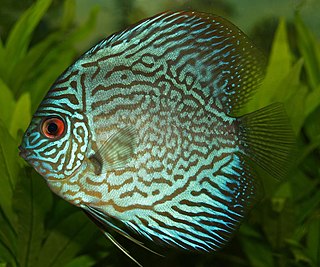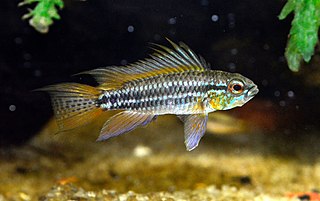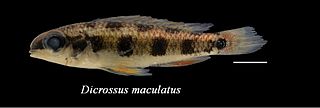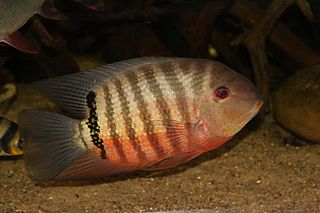
Symphysodon, colloquially known as discus, is a genus of cichlids native to the Amazon river basin in South America. Due to their distinctive shape, behavior, and bright colors and patterns, discus are popular as freshwater aquarium fish, and their aquaculture in several countries in Asia is a major industry. They are sometimes referred to as pompadour fish.

The Rio Negro, or Guainía as it is known in its upper part, is the largest left tributary of the Amazon River, the largest blackwater river in the world, and one of the world's ten largest rivers by average discharge.

Apistogramma is a large genus of freshwater fish in the family Cichlidae found in South America, but also commonly kept in aquariums. They are dwarf cichlids that mostly feed on tiny animals and have breeding behaviors that vary depending on the exact species.

Aequidens is a genus of fish in the family Cichlidae found in South America. Formerly a wastebasket genus, as presently defined Aequidens is largely restricted to the Amazon Basin, Orinoco Basin and river basins in The Guianas. The only exceptions are A. plagiozonatus which also occurs in the Paraná Basin, and A. tetramerus which also occurs in the Parnaíba River.

Geophagus is a genus of cichlids that mainly live in South America as far south as Argentina and Uruguay, but a single species, G. crassilabris is from Panama. They are found in a wide range of freshwater habitats. They are part of a group popularly known as eartheaters and mostly feed by picking up mouthfuls of sediment to sift out food items such as invertebrates, plant material and detritus. The largest species reach up to 28 cm (11 in) in standard length. They are often kept in aquariums.

Hypselecara is a small genus of cichlids native to the Amazon and Orinoco basins in South America. H. temporalis is a relatively common aquarium fish known in the aquarium trade as the chocolate cichild.

Uaru is a small genus of cichlids found in blackwater and whitewater habitats in the upper Orinoco and the Amazon basin.

Dicrossus is a genus of small cichlid fishes native to rivers in the Amazon and Orinoco basins in South America. These cichlids have several dark spots on the sides of their bodies. Depending on the species, they typically only reach 4–7 cm (1.6–2.8 in) in length.
Heros severus, is a species of tropical freshwater cichlid native to the upper Orinoco and upper Rio Negro basins in South America. It has historically been confused with several other species in the genus, most recently H. liberifer.

Nannacara is a genus of small freshwater cichlid fish endemic to South America. The genus is part of the Cichlasomatini tribe of the Cichlasomatinae subfamily. In the aquarium hobby, the fish is considered a dwarf cichlid along with Apistogramma, Mikrogeophagus, and Dicrossus species. Nannacara anomala is the most commonly encountered species in the aquarium trade.

Satanoperca is a small genus of cichlids from South America, where they are known from the Orinoco, Essequibo, Nickerie, Amazon and Paraná–Paraguay river basins. They are mainly found in areas with slow-moving waters, but some species have also been recorded from rapids.

Hoplarchus is a genus of cichlid in the tribe Heroini. It contains the single species Hoplarchus psittacus, which is endemic to the blackwater rivers in Brazil, Colombia and Venezuela, including the Rio Negro, Jamari, Preto da Eva, Urubu rivers and upper Orinoco drainages. This fish can reach a length of 35 centimetres (14 in) TL and is important as a food fish to local indigenous peoples. This species is occasionally kept as an aquarium fish and is traded under the common name "parrot cichlid".

Haplochromis is a ray-finned fish genus in the family Cichlidae. It has been used as the default "wastebin taxon" for Pseudocrenilabrinae cichlids of the East African Rift, and as such became the "largest" fish "genus". Many of these cichlids are popular aquarium fishes; like similar Haplochromini they are known as "haplos", "happies" or "haps" among aquarium enthusiasts.

Laetacara is a small genus of cichlids native to freshwater habitats in tropical and subtropical South America, ranging from the upper Orinoco River basin in Venezuela to the Paraná River basin Argentina. The genus is also collectively known as the smiling acaras. Like all cichlids, Laetacara species have well-developed brood care.

Mesonauta, the flag cichlids, is a small genus of cichlids native to the Amazon, Orinoco, Essequibo, Paraná and Paraguay basins in South America. Mesonauta is included in the subfamily Cichlasomatinae. They occur in various freshwater habitats such as streams and lakes, especially in areas with little water movement and aquatic vegetation. They are generally found in small groups that stay near the water surface. To avoid predators, adults may jump out of the water and juveniles mimic leaves.

Andinoacara is a genus of fish in the family Cichlidae. The genus was described in 2009. Before this the members of Andinoacara were placed in the "catch-all" genus Aequidens although they are not closely related to the other members of this genus. The genus Andinoacara is restricted to freshwater habitats in northwestern South America and southern Central America. There are no members of the genus in the Amazon Basin.

Heros efasciatus is a species of tropical freshwater cichlid native to the Amazon basin in South America. It is commonly found in the aquarium trade, often in its gold colored variation rather than the wild-type olive green one.

Heros liberifer is a species of tropical cichlid native to lentic habitats, especially flooded forests, in the upper and middle Orinoco basin in South America.

Heros notatus is a species of tropical freshwater cichlid native to Rio Negro and Essequibo River in South America.

The saddle cichlid is a species of cichlid from the tribe Cichlasomatini, part of the subfamily Cichlasomatinae from South America. It is the type species of the genus Aequidens. It is reasonably common in the aquarium trade.



















